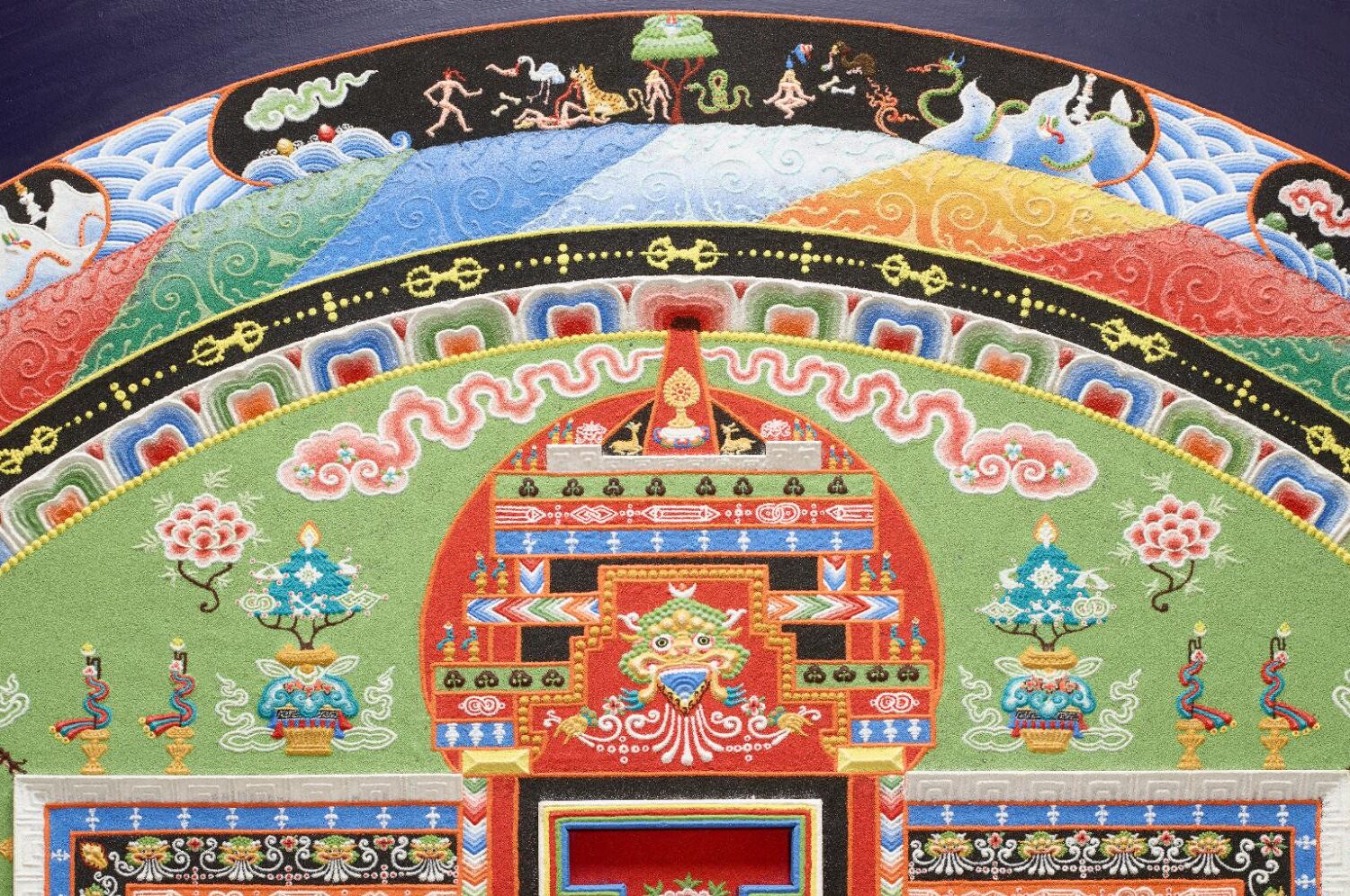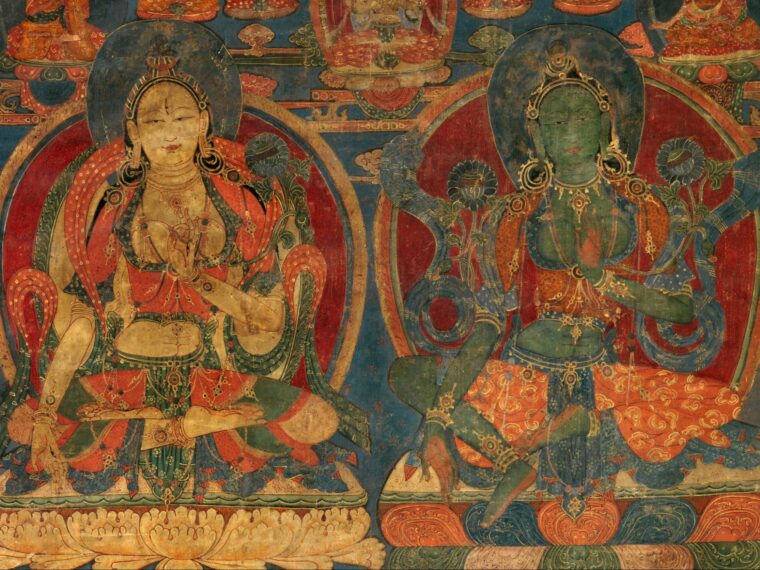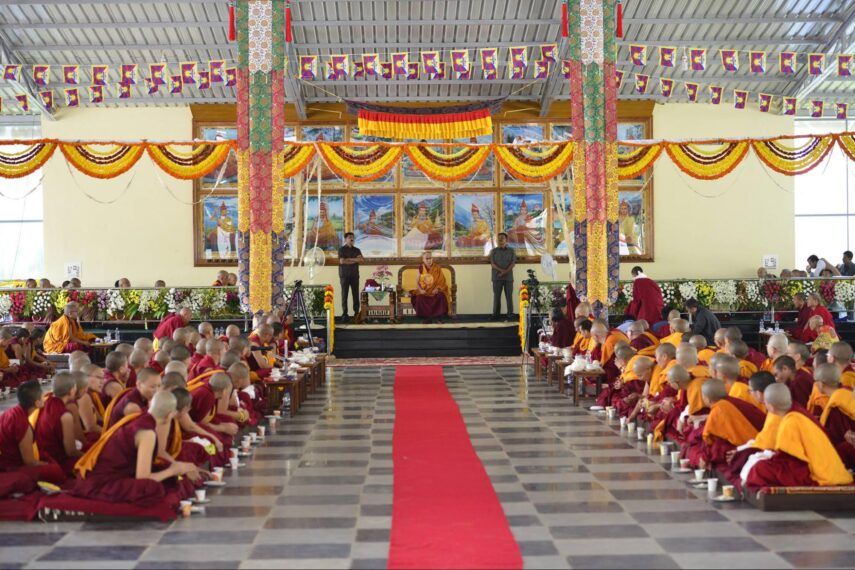
The Tibetan Sand Mandala: A Short History
On September 14, 2025, join us for Family Day to celebrate Mia’s first anniversary of the opening of the “Tibetan Buddhist Shrine Room: The Alice S. Kandell Collection.” This event features a Shrine Room Stop and Chat with Mia Guides, a Tibetan Shrine gallery hunt, and the WOW Mobile Metal Lab. Experience and appreciate Tibetan culture, history, and community at Mia!
By Rob Bedeaux
August 26, 2025—In celebration of the opening of the “Tibetan Buddhist Shrine Room: The Alice S. Kandell Collection” on September 14, 2024, Tibetan Nuns from the Jangchub Choeling Nunnery assembled a sand mandala the week of September 9, 2024, at Mia. Mia encouraged visitors to observe the nuns as they created this intricate work. After a week on view, on the morning of Saturday, September 21, 2024, the nuns dismantled the Green Tara Sand Mandala and dispersed it into the Mississippi River.
- → Watch: Green Tara Sand Mandala at Mia
Interested in learning more about the Tibetan tradition of sand mandalas? Here’s a quick guide to the art and history of sand mandala making.

Chenrezig Sand Mandala was created and exhibited at the British House of Commons in 2008, during the Dalai Lama’s visit.
What Is a Sand Mandala?
Mandalas, pronounced muhn-DAH-luh, are artistic representations of the residential palaces or cosmic realms associated with particular deities, who are represented in the center.
Tibetan Buddhists have long created mandalas out of colored sand as a way to manifest their beliefs in the physical world. The mandala’s creation and consecration are believed to benefit beings, while their destruction serves as a reminder of the ephemerality of life and the impermanence of all things.
History of the Sand Mandala
Some Buddhists believe that Shakyamuni (Buddha) taught the art of sand mandala construction in India in the fifth or sixth century BCE. In this tradition, it also states that the knowledge has been passed down, unbroken, for more than 2,500 years. Through the centuries, it has been incorporated into many Eastern religions, including Hinduism, Buddhism, Jainism, and Shinto.
Sand mandalas were documented in Tibet as early as the 11th century, and the Tibetan term dul tson kyil khor means “made of powdered colors.” The geometric designs are first drawn by a qualified lama, after which purification rites are conducted to bless the monks or nuns who will undertake the mandala’s creation. Starting at the center, they work their way to the outer edge over several days. The sand is applied using a thin funnel-like tube. Rubbing a metal rod along the ridged exterior of the tube causes a gentle vibration that helps keep the sand running smoothly.
This sacred art form is not only a visual representation of specific qualities and energies but also serves as a tool for meditation, focusing the mind and fostering spiritual reflection. It’s a symbolic offering of the entire universe.
Every intricate detail of the mandala is fixed in the tradition and has specific symbolic meanings, often on multiple levels. In the Tibetan religious tradition, it’s believed that the process of creation gathers spiritual energy. Then the destruction distributes that energy back to the natural world, where it can be used again.
Creation and Destruction
The creation and destruction of a sand mandala is a profoundly spiritual practice, symbolizing the impermanence of all things. The process begins with the consecration of the site where the mandala will be constructed. The ritual includes dance and prayer chants, which purify the site for the mandala.
Once the site is purified, individual grains of colored sand are placed using tubes, funnels, and scrapers. The process can take days, resulting in an elaborate geometric pattern filled with sacred symbols.
The destruction of a sand mandala is known as the Dissolution Ceremony. Sand is swept toward the center until it is a small grey pile. This sweeping represents the impermanence of everything in the universe. The sand is then collected in a jar and released back into nature. It’s believed that the dissolution disperses the healing energies of the mandala into the water and throughout the world.
Green Tārā and the Green Tārā Mandala
Every mandala is believed to house the essence of a particular deity and imbue certain qualities. The mandala created at Mia, in partnership with the Tibetan American Foundation of Minnesota and the Jangchub Choeling nuns, was a Green Tārā Mandala.
Green Tārā is a central deity in Tibetan Buddhism. She is believed to be incarnated as the Nepali princess Bhrikuti Devi, whose influence helped establish Buddhism in Tibet. She embodies happiness, peace, and prosperity, and is often depicted with a green complexion. Tārā is a protector who responds quickly to the cries of those in distress, offering relief from fear and suffering.

White Tara and Green Tara. Western Tibet (Guge). Distemper on cloth, 20 1/4 x 20 in. (51.4 x 50.8 cm). In this unique arrangement of an extremely rare subject, two Taras are seated on lotus thrones rising from pools set in a mountainous backdrop. The White Tara, represented with the multiple eyes of omniscience, sits in meditation posture, while the Green Tara hangs one leg pendant. Both lower one hand in the boon-giving varada mudra.
Who Are the Jangchub Choeling Nuns?
In the early 1980s, the 14th Dalai Lama recommended establishing a nunnery to preserve Tibetan culture and provide philosophical education for women. This led to the founding of Jangchub Choeling Nunnery, which is located in Mundgod, South India. Today, it serves 308 nuns from Tibet, Nepal, Bhutan, the United States, France, Singapore, Taiwan, Mongolia, and India. It’s an institute for every woman who wants to pursue Buddhist philosophy.
The nuns study philosophy, grammar, and poetry with 10 monastic teachers and science with a lay teacher. Philosophy is the key subject for the nuns. During 17 years of study, they become scholars of the Five Great Canonical Texts.
After completing their studies, candidates are eligible to undertake the Geshema exams. This rigorous assessment includes four years of written and debate exams, as well as the completion and defense of a thesis. The Geshema Degree represents the highest level of training in the Gelugpa tradition and is akin to a PhD in Tibetan Buddhism. Notably, the degree was formally accessible to women in 2012, leading to the graduation of over 40 Geshemas, with approximately 32 individuals currently pursuing this esteemed degree.

Nuns at the Jangchub Choeling Nunnery
In 2024, the nunnery embarked on its first U.S. tour. The tour was designed as a way to share aspects of Tibetan culture and raise funds for the nunnery, with a focus on health care. In preparation for the trip, the team studied five mandalas, training with monks for the previous year. This was the first time that nuns started learning this specific training in the nunnery. The four nuns, including one Geshema and their former Abbot, Khensur Geshe Tashi Tsering of Gaden Shartse Monastery, and their coordinator, Ms. Lobsang Chime, traveled throughout the U.S. with stops in Minnesota, Ohio, Kentucky, New York, Maine, Illinois, Massachusetts, and Washington, D.C.
Did You Know?
Crushed precious stones were traditionally used to create a mandala, but today it’s often plain white stones or marble dust dyed with opaque inks or food coloring.
Small tubes, funnels, and scrapers called chak-pur are the tools used to create a mandala.
Sand mandalas are unique to Tibetan Buddhism and are believed to emanate healing and purification.
The word mandala translates to “circle” in Sanskrit (मण्डल).
There are three main types of mandalas seen across world cultures and religions: teaching mandalas, healing mandalas, and sand mandalas.
About the Room
The “Tibetan Buddhist Shrine Room: The Alice S. Kandell Collection” includes more than 200 gilt-bronze sculptures, paintings, silk hangings, and carpets that were created in Tibet between the 1300s and early 1900s. Buddhist ritual objects are displayed in the context of an elaborate private household shrine, a space used for offerings, devotional prayer, rituals, and contemplation. With its flickering candlelight, sonorous chanting, and the subtle smell of incense, the glittering room provides an oasis for peaceful contemplation within the galleries at Mia. The room is on view in Gallery 256.
